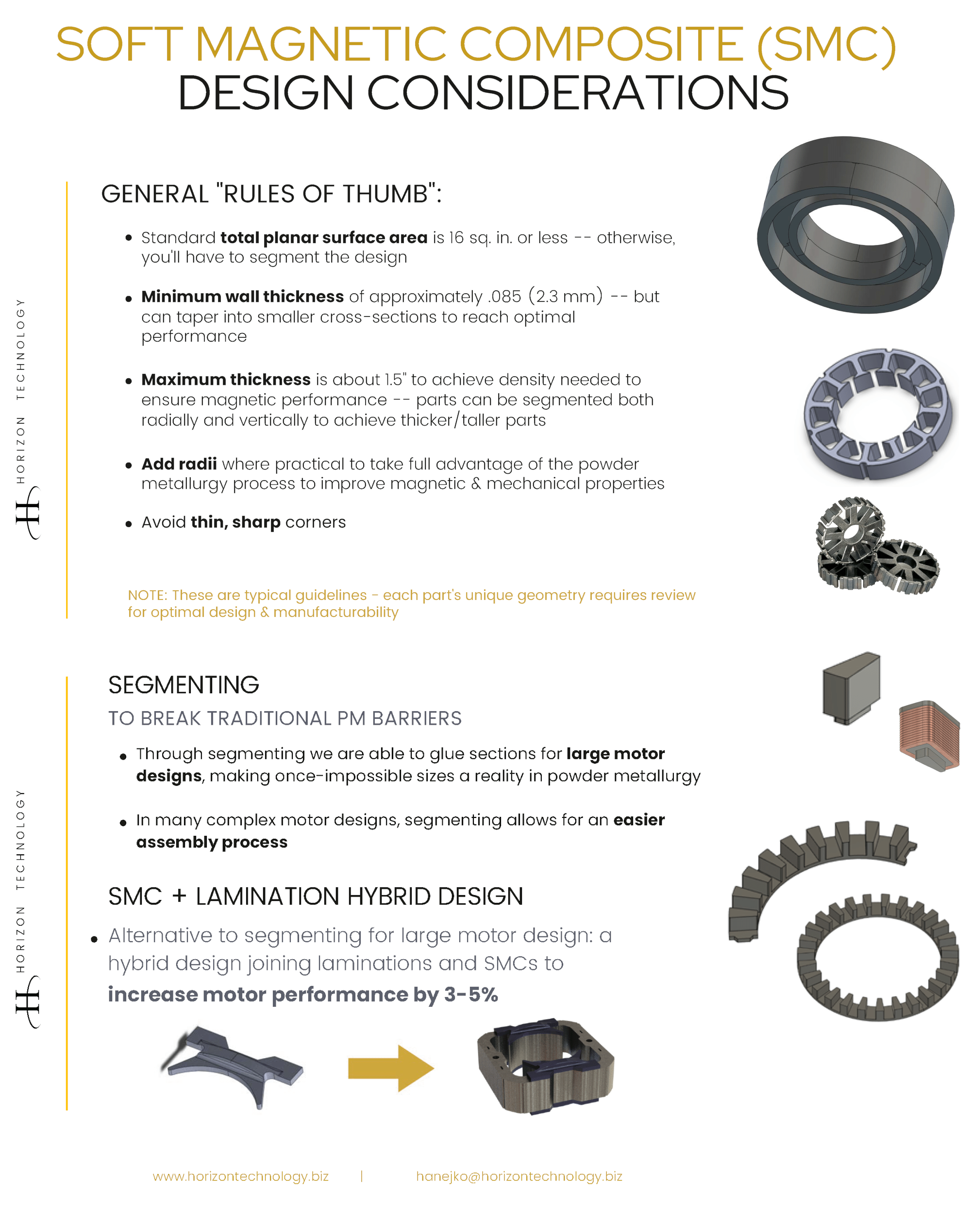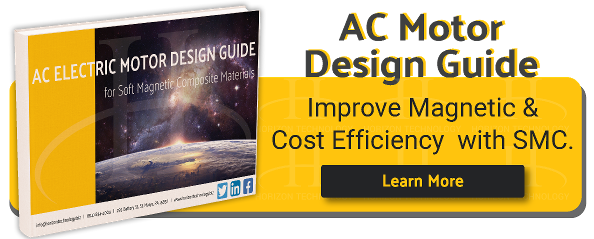If you’re reading this, you’re likely interested in designing and producing a more compact, higher-performance electromagnetic product. You’re in the right place -- soft magnetic composite materials play a fundamental role in the continued drive toward greater cost and energy efficiency.
Many new customers have questions about this emerging branch of powder metallurgy. Below are the questions we hear most about soft magnetic composites (SMCs):
Soft Magnetic Composite Frequently Asked Questions
Q: Why are they called ‘soft’ magnetic composites?
A: “Soft” refers to materials that are soft in the magnetic sense. The term has nothing to do with the materials’ hardness.
A soft magnet is easily magnetized and demagnetized. A permanent, or “hard,” magnet always maintains magnetization.
Why would you not necessary want a hard magnet? You want to be able to switch that magnetic field easily and quickly. This gives you the ability to rotate something -- like a motor or stator. A hard magnet requires so much current to do that, it's an inefficient solution.
Soft magnetics, though? Perfect for motors and stators.
Q: What materials/metals are used in soft magnetic composites?
A: Soft magnetic composite materials consist of iron powder particles (with high purity and compressibility) bonded together with a thin, uniform layer of both organic and inorganic material. The coating provides high electrical resistivity, insulating each individual particle (which restricts eddy current creation).
The coated powder is pressed into a die to form a solid material, which is then heat-treated using low temperatures to cure the bond.
An SMC material is defined by:
-
Its base powder
-
Carefully selected additives
-
The processing route
This enables powder metal parts makers to tailor properties to meet a multitude of AC application requirements.
Powder metal materials we recommend using are SMC 700 1P, SMC 700 3P, and SMC 700 5P. The key variables for each of these materials are density and processing. Density affects:
-
Permeability
-
Induction
-
Saturation induction
-
Total core losses
Note that many other grades of soft magnetic powder are available for higher-frequency applications. Consult with Horizon Technology or another maker of high-complexity parts for information on these materials and their applications.
(Related: SMC Resource Center for Beginners & Advanced Design)
Q: What are the benefits of soft magnetic composites?
A: How much time do you have? Soft magnetic composites provide solutions that deliver:
-
Compact designs -- size and weight can both decrease sharply.
-
Design of complex shapes -- opening up a wide range of options for component and product design. SMCs use the inherent shape-making capabilities of powder metallurgy to produce novel shapes for electrical devices.
-
High performance -- meeting the highest efficiency requirements. Higher density, permeability, induction, and frequencies are possible. Eddy losses are reduced compared with other processes (see below).
-
Cost efficiency – compact designs require less material by facilitating a simple net shaping process with minimal waste and need for secondary operations. The need for complex assemblies disappears. Efficient motor design can also lead to electricity savings for your end customer, too.
Soft magnetic composites are ideal for AC electrical applications. SMCs have 3-D flux carrying capability ideal for axial flux motors and pancake motors, along with similar applications.
Q: What unique properties do SMCs offer vs. traditional laminated steel cores?
A: Reduced production costs are not only possible, but probable with soft magnetic composites. (Another question below gets deeper into costs.)
SMCs offer the same shape-making potential as traditional powder metallurgy processing. Benefits of SMCs versus steel laminations include:
-
Flexible component design -- Think of powder metal as batter or sculpting clay. stacks of laminations are necessary to create a 3-D shape, but with SMC a 3-D shape is achieved by pressing the material into the required shape in one step. The ability to make rounded parts with little after-machining saves money on copper windings.
-
Reduced assembly sizes -- laminations require assembly to create a 3-D shape. By assembly, we mean numerous laminations stacked together, each a little smaller than the previous one, to create a rounded shape. SMC allows for more simple, rounded designs. Assemblies can be reduced from 1,000+ parts to under 10 -- really. Naturally, this results in a more lightweight assembly.
-
Lower total core loss -- at medium and high frequencies. This benefits the your project’s maximum power rating and running costs.
-
Little secondary machining -- because powder metallurgy creates net shape parts, there is little extra after-work necessary. Steel laminates are stamped from long sheets of thin steel often, with considerable waste of the starting material. Laminations are then either staked or welded to form the final product. Complex shapes require multiple stamping dies and assembly of these various-sized shapes.
SMCs are a viable alternative to steel laminations in a wide range of applications, including fast-switching solenoids, rotating machines, and sensors.

Q: What limitations do soft magnetic composites have compared with laminations?
A: When compared to laminations, soft magnetic composites do have a few limitations.
SMC components are lower in strength, which translates into limited applications in use as a rotating component. The rapid spinning could crack a brittle component. SMCs are also less permeable, which in select cases may be undesirable, and provide lower magnetic saturation.
Depending on the size of the lamination assembly, pitfalls may spread to run speed, too. A low-complexity lamination assembly may take less time to manufacture than an SMC component.
Finally, in some cases, it may just not be worth the effort to switch to a soft magnetic composite. For example, it’s hard to justify using one for a traditional 50/60 HZ motor when a lamination assembly works just fine.
Q: What is the cost of Soft Magnetic Composites?
A: Most roads in manufacturing lead to cost. The big-picture savings in final component cost are significant in powder metallurgy.
Costs will vary from one component to another, with several factors coming into consideration, most of all the component’s size and design complexity. Rest assured, though, that soft magnetic composites are cost-effective for most designs. SMC designs require fewer and more manufacturable parts, which takes design consolidation to the next level.
An SMC part can also be combined with a laminate or sintered component, providing innovative design options and unparalleled versatility, all at a smaller price tag.
Don’t forget about the copper savings. Designing with SMCs means you can create round corners and compact winding. Copper is a very expensive metal, so this is a big win.
For More Information ...
SMCs allow revolutionized designs of electromagnetic devices, which translates into improved efficiency and reduced weight and costs, with no sacrifice of magnetic performance.
If you need more information on these materials -- whether your knowledge level is beginner or advanced -- check out these resources on soft magnetic composites. The free e-book below also gives a more in-depth visual explanation of SMCs.
If you’re still stumped on your design process, you can also contact us directly!



